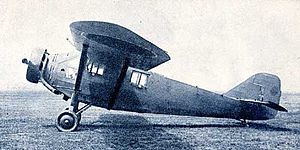Mitsubishi K3M Video - Picture

|
|
Mitsubishi K3M
K3M2

Picture - K3M3
Role: training aircraft
Manufacturer: Mitsubishi
First flight: 1930
Introduced: 1931
Primary user: IJN Air Service
Number built: 625
The Mitsubishi K3M2 (ä¹ãå¼æ©ä¸ä½æ¥ç·´ç¿æ©, KyÅ«rei-shiki kijÅ sagyÅ renshÅ«ki) was a trainer built by Mitsubishi which was used widely in the Imperial Japanese Navy from World War I through the end of World War II in an extremely wide variety of roles, including light transport, liaison aircraft, utility aircraft and occasionally light bomber. Its Allied reporting name was Pine.
Design & Development
The Mitsubishi K3M was, designed by British aeronautical engineer and aircraft designed Herbert Smith, from Sopwith working in Japan for Mitsubishi. The prototype, designated Mitsubishi 4MS1, made its maiden flight in 1930. The aircraft was strut-braced high-wing cabin monoplane, with fixed wide-track landing gear, and was powered by a single 300 hp (220 kW) water-cooled radial piston engine. Pilot and gunner were located in separate open cockpits, with an instructor and two pupils in the enclosed cabin in the fuselage. Later passenger variants seated five passengers in the cabin.
Total production of all versions was around 625 aircraft, with production mostly undertaken by KyÅ«shÅ« HikÅki K.K. and Aichi Kokuki. Production continued until 1941, and examples pressed into service as liaison aircraft in the postwar period were found in a variety of national markings.
Operational history
The first version of the K3M offered to the Imperial Japanese Navy Air Service was prone to stability problems, and more importantly, problems with the water-cooled 340 hp (250 kW) Mitsubishi-built Hispano-Suiza eight-cylinder liquid-cooled engine driving a two-blade wooden propeller.
The improved K3M2 used a Hitachi Amakaze 11 nine-cylinder air-cooled radial engine, rated at 340 hp (250 kW) for take-off and 300 hp (220 kW) at sea level, driving a two-blade wooden propeller. The first K3M2 production version entered service in 1932 as the Navy Type 90 Crew Trainer. It was superseded in production with the K3M3, using a Nakajima Kotobuki 460 hp (340 kW) air-cooled engine.
The Navy Type 90 Crew Trainer was primarily a land-based aircraft; however, a few were converted with floats for use as seaplanes.
The Imperial Japanese Army Air Force had an interest in the aircraft as part of its modernization program, and as a potential supplement to the Nakajima Ki-6. Two examples were acquired and tested, and the airframe was given the designation of Ki-7. One prototype used a 475 hp (350 kW) Mitsubishi Type 92 nine-cylinder air-cooled radial engine and the other a 450 hp (340 kW) Nakajima Kotobuki nine-cylinder air-cooled radial engine. However, the IJAAF opted not to go into production with either version.
The civil version offered to commercial operators was with a 420 hp (310 kW) Nakajima-built Bristol Jupiter VI nine-cylinder air-cooled radial engine. The Mitsubishi K3M was used for both civil and military roles with some remaining in operation until well after World War II.
Variants
Mitsubishi K3M1 Initial test version Mitsubishi K3M2 (Japanese Navy Type 90 Crew Training Aircraft) Initial production version for Imperial Japanese Navy Mitsubishi K3M3 (Japanese Navy Type 90 Crew Training Aircraft) Final production version for Imperial Japanese Navy Mitsubishi K3M3-L Military transport used by Imperial Japanese Navy Ki-7 Proposed version for Imperial Japanese Army, 2 built Mitsubishi MS-1 Civil transport version
Operators
Military operators
Japan
Imperial Japanese Navy Air Service
Specifications (K3M3)
General characteristics
Crew: 4
Capacity: 6
Length: 9.54 m (31 ft 4 in)
Wingspan: 15.78 m (51 ft 9 in)
Height: 3.82 m (12 ft 6 in)
Wing area: 34.5 m² (371.35 ft²)
Empty weight: 1360 kg (2998 lb)
Gross weight: 2200 kg (4850 lb)
Powerplant: 1 x Nakajima Kotobuki-2, 435 kW (580 hp)
Performance
Maximum speed: 230 km/h (143 mph)
Range: 790 km (491 miles)
Service ceiling: 6389 m (20,950 ft)
Rate of climb: 8.77 m/s (1726 ft/min)
Armament
1 x 7.7 mm Type 92 machine gun, rear mounted
4 x 30 kg (66 lb) bombs
Bibliography
Francillon, Ph.D., René J. (1979). Japanese Aircraft of the Pacific War. London: Putnam & Company Ltd.. ISBN 0370302516.
Mikesh, Robert C.; Shorzoe Abe (1990). Japanese Aircraft, 1910-1941. Annapolis, MD: Naval Institute Press. ISBN 1557505632.
Mitsubishi K3M Pictures
Living Warbirds: The best warbirds DVD series.
Source: WikiPedia